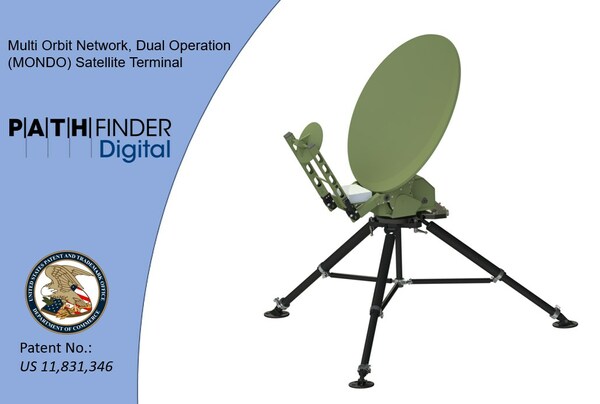PathFinder Digital has been issued U.S. Patent # 11,831,346 by the United States Patent and Trademark Office for the firm’s SATCOM antenna system that was developed to address the challenges faced by military personnel in maintaining continuous and agile communication links on GEO, LEO and MEO networks.
This new VSAT design offers unparalleled adaptability and interoperability, providing users with the ability to communicate with any available satellite network, regardless of the orbital configuration. PathFinder has named the new terminal concept “MONDO,” which stands for Multi Orbit Network, Dual Operation terminal.
Traditionally, satellite ground terminals have been designed to operate in a dedicated fashion on a specific communication satellite or network. This has limited their ability to quickly reconfigure to communicate with alternative satellites, a vital capability in times of conflict or when facing satellite disruptions due to hostile actions, on-orbit failures, or other factors.
MONDO addresses the shortcomings of parabolic reflector antennas and electronically scanned arrays (ESAs) when used as a standalone. While parabolic reflector antennas offer high gain, they can be slow, cumbersome, and prone to mechanical failure when operating on LEO or MEO. On the other hand, ESAs provide fast electronic beam steering and a low-profile design, ideal for mobile platforms and when operating on MEO or LEO, but suffer from lower gain especially on GEO satellites. The lower gain performance of ESAs on GEO satellites is especially a disadvantage in many military applications where the majority of the data transfer is from the user to the satellite (uplinked), rather than from the satellite to the user (downlinked).
The MONDO design uses a primary and secondary parabolic reflector in combination with a phased array antenna/ESA. The phased array antenna is used as the feed for the parabolic reflector when operating on a GEO satellite and as a standalone antenna when operating on a LEO or MEO satellite. This configuration also allows MONDO to function concurrently as a traditional parabolic antenna on a GEO satellite and as a traditional ESA on a LEO/MEO satellite. Variations of the MONDO design could incorporate the parabolic antennas and/or ESAs from a variety of antenna manufacturers.
MONDO provides users with a single ground terminal antenna system that combines the best characteristics of parabolic antennas with the best characteristics of ESAs. The ideal MONDO use scenarios are “Flyaway” terminals (transportable case-based systems) as well as “Drive-Away” terminals (vehicle mounted) when operating “At-The-Halt.”
While there is significant and growing demand for terminals that operate “On-The-Move,” the majority of military terminals operate when stationary making the MONDO ideal for this application. Presently fielded military terminals could even be upgraded to the capabilities offered by the MONDO design, giving them multi-network capability. Future generations of the MONDO terminal will offer multi-band capability as dual band Ka-/Ku-band ESAs are developed.
MONDO offers increased adaptability, allowing for seamless communication with multiple satellites simultaneously. This ensures high availability rates and the ability to switch communication from one satellite to another when necessary.
Key features of the MONDO satellite communications terminal include:
- Compatibility with multiple satellite network architectures and use scenarios without time-consuming and costly hardware changes or system reconfigurations.
- Operation on disaggregated SATCOM network platforms, including government, commercial, and international systems.
- The use of various frequency bands, baseband hardware, and waveforms.
- Adaptability for installation on various platforms whether vehicle/trailer mounted or transported in cases.
- Use of advanced antenna technologies, including Passive Electronically Scanned Array (PESA), Active Electronically Scanned Array (AESA), Hybrid Phased Array, Digital Beam Forming (DBF) Array, and/or Hybrid Beam Forming (HBF) Array.
“We expect this breakthrough technology to enhance the military’s ability to maintain secure and reliable satellite communications in an increasingly complex and contested environment. With the capacity to quickly transition between satellites and operate in different orbital configurations and frequency bands, the MONDO terminal offers a significant advantage in maintaining communication links in critical military operations. PathFinder intends to license this innovative antenna design to antenna manufacturers.” — Roger McGarrahan, CEO of PathFinder Digital.

